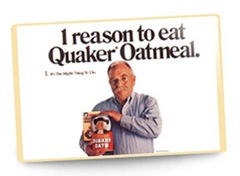
There’s a similar story about index funds for investing: it would be to the benefit of every investor to choose index funds as the core of his or her investment strategy. In this case, the part of Wilford Brimley is being played by Burton Malkiel – venerable author of the classic book A Random Walk Down Wall Street. And again most folks, especially those of us who deem ourselves too sophisticated for such a bland, tasteless, boring investment, choose to use much more exciting investment vehicles – often to our detriment as well.
According to Malkiel in his book – The Elements of Investing – while people of modest means are hurt most by not saving regularly, wealthy folks suffer the most damage by trying to find the “home run” sort of investments pushed by actively managed funds and stock-picking gurus. “If I took all the mutual funds that existed in the early 1970s and asked the question of how many really beat the market through 2009, you can count them on the fingers of one hand”, says Malkiel.
Benefits of Oatmeal (and indexes)
From reports by the American Cancer Society, the great benefits of oatmeal in your diet include the fact that it’s a source of both soluble and insoluble fibers. These two fibers give us diversification across these food “asset classes” that provide the benefits of reducing bile acid toxicity, reducing LDL cholesterol (that’s the bad kind), slowing digestion and absorption of starch, all the while providing us with vitamin E, zinc, selenium, copper, iron, manganese, magnesium and protein. It’s almost as if oatmeal provides us with all the good things we need, and canceling out all the bad – and the diversity of providing all these good things in one package makes oatmeal the perfect food!
An index fund (or a group of index funds covering all asset classes) provides the investor with similar benefits – diversification across all possible investments, providing the average “good” returns while canceling out the bad or negative returns.
It’s safe to say that a diet consisting solely of oatmeal probably wouldn’t be good for you, and no one is suggesting that. A proper diet requires many other things that just aren’t present in oatmeal. If, however, you did include all of those other things – fruit, dairy, and the like – in your oatmeal, you actually could do far worse than choosing a steady diet of your “super oatmeal” all the time. It’s kind of like choosing more than one type of index fund for investing – except that we humans need variety in our diet to keep us satisfied. There’s no inherent need for this satisfaction variety in our investments.
So if you started your investing diet with a blend of two oatmeals – the aggregate bond market index and the total domestic stock market – and then tossed in a portion of some fruits and veggies: the aggregate Europe, Australasia and Far East equity markets, a dollop of emerging equity markets, plus a pinch or two of global equities, then a portion of domestic and global real estate (for that yummy crunch!). Now you’ve got yourself a super oatmeal for investing – providing everything you need to balance your investment tastes. Plus, you don’t have to pay a restaurant (managed fund company) to provide you with a menu, nor do you have to pay extra for a chef (mutual fund manager).
The good thing is that the appetite of our investment accounts doesn’t really need the “filet mignon” or “lobster” sort of investments to maintain proper balance. The steady diet of our “oatmeal” index funds, properly diversified, is plenty for investors of all walks of life.
Disclaimer: I don’t personally eat oatmeal, but I do eat an oat-based cold cereal for breakfast every morning – pretty much the same thing, only a little more convenient for me. Liken it to the difference between a no-load index fund and an ETF.
Photo by Quaker Oats